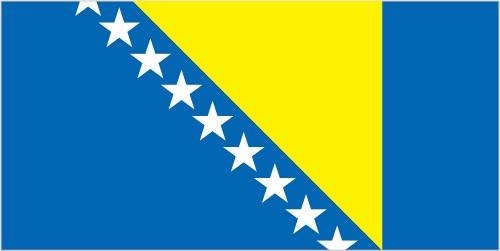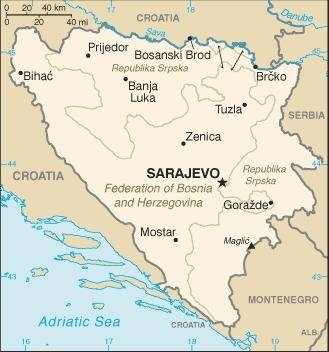59 Bosnia and Herzegovina

A wide blue vertical band on the fly side with a yellow isosceles triangle abutting the band and the top of the flag. The remainder of the flag is blue with seven full five-pointed white stars and two half stars top and bottom along the hypotenuse of the triangle. The triangle approximates the shape of the country and its three points stand for the constituent peoples – Bosniaks, Croats, and Serbs. The stars represent Europe and are meant to be continuous (thus the half stars at top and bottom); the colors (white, blue, and yellow) are often associated with neutrality and peace, and traditionally are linked with Bosnia.
Flag courtesy of the CIA World Factbook

Map courtesy of the CIA World Factbook

The Cathedral of Jesus’ Heart is the largest cathedral in Bosnia and Herzegovina and is the center of Catholic worship in the city of Sarajevo. Located in the Old Town district, the church was constructed between 1884 and 1889 in the Neo-Gothic style, but displays Romanesque elements. Although damaged during the Siege of Sarajevo (1992-1994), it has been completely restored.
Photo courtesy of the CIA World Factbook
Government
According to Britannica, the internationally brokered Dayton Accords, the peace agreement negotiated in Dayton, Ohio, U.S., in November 1995, established Bosnia and Herzegovina as a state composed of two highly autonomous entities, the Republika Srpska (Bosnian Serb Republic) and the Federation of Bosnia and Herzegovina. The latter is a decentralized federation of Croats and Bosniaks. Each entity has its own legislature and president. The central institutions of Bosnia and Herzegovina include a directly elected tripartite presidency, which rotates every eight months between one Bosniak, one Serb, and one Croat member. The presidency, as the head of state, appoints a multiethnic Council of Ministers. The chairman of the council, who is appointed by the presidency and approved by the national House of Representatives, serves as the head of government. The parliament is bicameral. Members are directly elected to the 42-seat lower house (House of Representatives), in which 28 seats are reserved for the Federation and 14 for the Republika Srpska. Members of the upper house (the House of Peoples, with five members from each ethnic group) are chosen by the entity legislatures. The central institutions of Bosnia and Herzegovina are weak, with the bulk of governmental competencies residing in the two entities. Internationally led efforts to replace the unwieldy and costly constitutional structure of Bosnia and Herzegovina with a more functional one, capable of integrating into the European Union, have been opposed by the country’s nationalist leaders.
The Federation of Bosnia and Herzegovina is decentralized; it is administratively divided into 10 cantons, which in turn are divided into dozens of municipalities (općine). The Republika Srpska is relatively centralized and is administratively divided into dozens of municipalities (opštine). Citizens of both entities directly elect mayors and representatives to municipal and cantonal assemblies. Arbitration in 1997 established Brčko, in the northeast, as a self-governing special district.
The Dayton Accords established the Constitutional Court, which has exclusive jurisdiction to decide any dispute that arises between the entities, between Bosnia and Herzegovina and the entities, or between the institutions of Bosnia and Herzegovina. Three of the nine members of the Constitutional Court are appointed by the president of the European Court of Human Rights; the others are selected by the entities. The State Court, comprising administrative, appellate, and criminal divisions, has jurisdiction over matters regarding national law. Each entity also has its own Supreme Court and lower courts. Since its establishment by the United Nations Security Council in 1993, the International Criminal Tribunal for the Former Yugoslavia has exercised jurisdiction over grave breaches of the Geneva Conventions as well as for war crimes, genocide, and crimes against humanity. In 2002 Bosnia and Herzegovina’s national courts gained jurisdiction over cases that did not involve major political and military figures.
Directorate of Civil Aviation
The Bosnia and Herzegovina Directorate of Civil Aviation as an authority responsible for performing regulatory functions, oversight and issuing licenses, permits and certificates in the field of civil aviation and air traffic control, was established in 1997 with a goal to respond to the numerous obligations of Bosnia and Herzegovina as a Member State of the International Civil Aviation Organization (ICAO) and signatory to the Chicago Convention. In addition, Bosnia and Herzegovina is a member of the European Civil Aviation Conference (ECAC), a full member of the Joint Aviation Authorities (JAA) and European Organization for the Safety of Air Navigation, and holds the observer status in the work of the European Aviation Safety Agency (EASA). Bosnia and Herzegovina ratified the European Common Aviation Area (ECAA) Agreement and signed a working arrangement with EASA, thus accepting the obligation to implement European Union regulations in the field of civil aviation. The BHDCA was established as part of the Ministry of Communications and Transport of Bosnia and Herzegovina (MKTBIH), and its organization, management, competences and responsibilities are regulated by the Aviation Law of Bosnia and Herzegovina and by the Rulebook amending the Rulebook on the internal organization of the MKTBIH.
Airspace
SkyVector – Google Maps – ADS-B Exchange
ICAO countries publish an Aeronautical Information Publication (AIP). This document is divided into three parts: General (GEN), En Route (ENR) and Aerodromes (AD). ENR 1.4 details the types of airspace classes they chose to adopt from classes A through G.
BHANSA
By establishing Bosnia and Herzegovina Air Navigation Services Agency (BHANSA), Bosnia and Herzegovina has provided the conditions for the beginning of taking control and management of its airspace. BHANSA was established in 2009. by adopting of the Law on Bosnia and Herzegovina Air Navigation Services Agency (“Official Gazette of BiH”, No. 43/09) as a non-profit and financially independent institution with the status of a legal entity. A headquarter of BHANSA is in Mostar, and other organizational units are arranged in Banja Luka, Sarajevo and Tuzla. On November 13, 2014, BHANSA has started to provide regional air traffic control services from the Air Traffic Control Unit (ATCU I) in the airspace of Bosnia and Herzegovina up to 10,000 meters (from FL 100 to FL 325). Bosnia and Herzegovina Air Navigation Services Agency (BHANSA) took control over Bosnia and Herzegovina’s airspace after midnight on December 4, 2019 thus opening a new chapter in the history of BH aviation.
Drone Regulations
Advanced Air Mobility (AAM) Regulations & Policies
None found by the author.
However, should you, the reader, happen to stumble across something to the contrary, please email the author at FISHE5CA@erau.edu and you may be mentioned in the ACKNOWLEDGEMENTS section of this book by way of thanks for contributing to this free eBook!
Advanced Air Mobility (AAM) News
None found by the author.
However, should you, the reader, happen to stumble across something to the contrary, please email the author at FISHE5CA@erau.edu and you may be mentioned in the ACKNOWLEDGEMENTS section of this book by way of thanks for contributing to this free eBook!
Short Essay Questions
Scenario-Based Question
You have been hired by a Drone Startup Company. Your boss has immediately assigned this job to you.
They need you to prepare a one-page memo detailing the legalities of using a drone over Sarajevo, pictured above.
They need you to mention any national laws and local ordinances.
They specifically want to know what airspace (insert pictures) you will be operating in and whether or not you need an airspace authorization.
Does it matter whether or not you are a citizen of the country?
Lastly, there is a bonus for you if, as you scroll through this chapter, you find any typos or broken links!
Short Essay Questions
- What are the drone categories?
- How is registration addressed?
- How is remote ID addressed?
- What are the model aircraft rules?
- What are the commercial drone rules?
- Are there waivers or exemptions to the rules? If so, for what?
- Would you share a link to an interactive airspace map?
- How is BVLOS addressed?
- How can you fly drones at night?
- How can you fly drones over people?
- Where do you find drone NOTAMs?
- What are the rules for drone maintenance?
- What are the rules for an SMS program?
- What are some unique rules not mentioned above?
- What are the C-UAS rules?
- What are the AAM rules?

